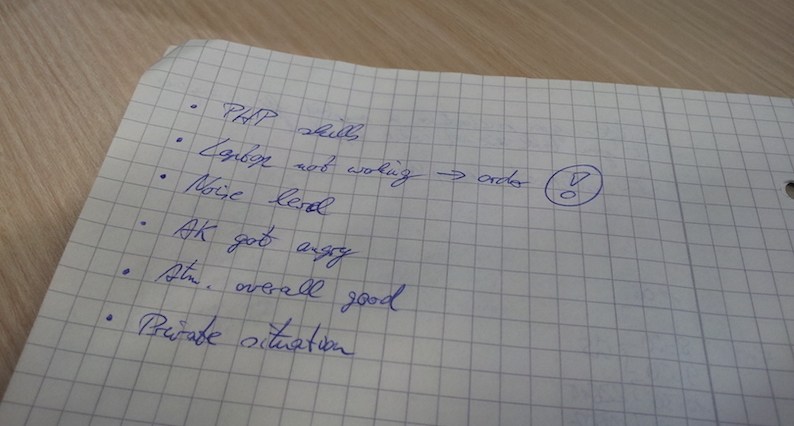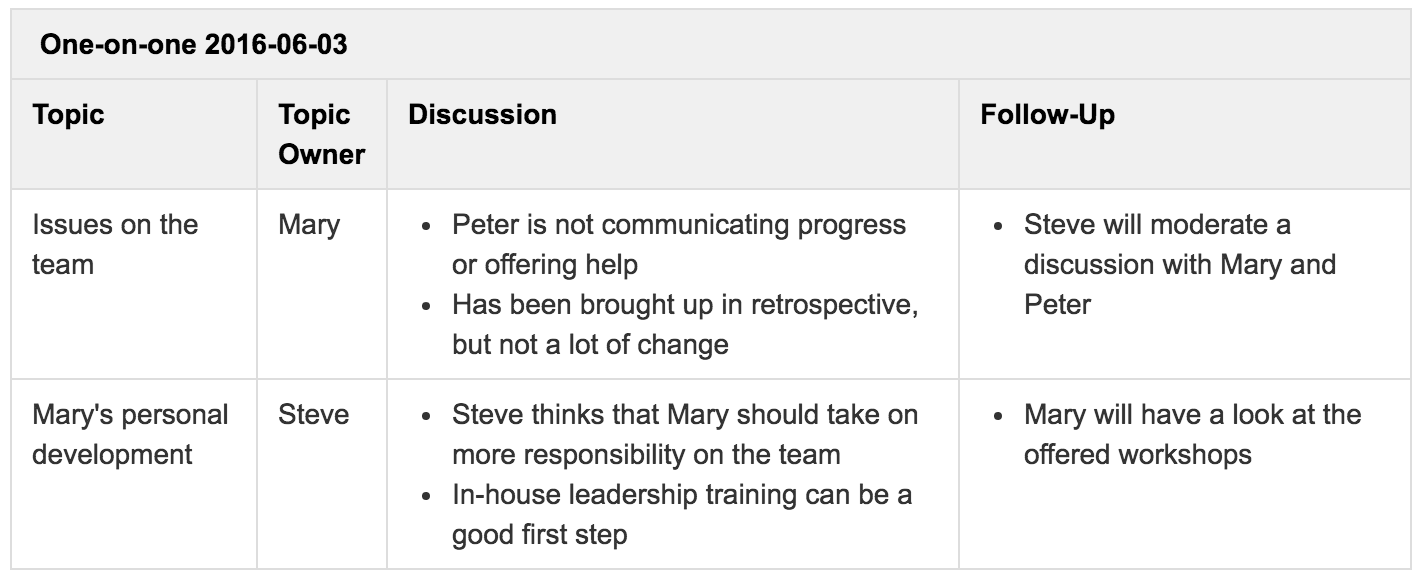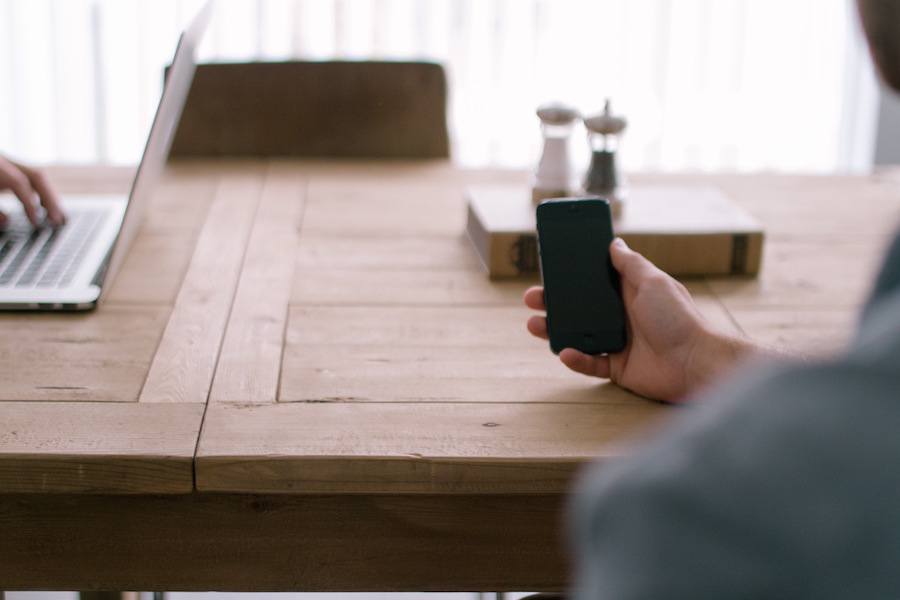I am struggling a bit with a seemingly minor question, and that question is if, how and when to take notes during 1:1 meetings. Ok, I think the “if” part can be handled pretty swiftly: Yes, you should take notes during 1:1s, because it signals to your employee that you take seriously what he says, that it will not be forgotten, and that you can be held accountable in case you fail to follow up on the action points discussed.

Multitasking
On the other hand, I sometimes get the feeling that being a good listener while writing or typing away like crazy is hard to do or even impossible, and for several reasons. The first reason is that I could never be a simultaneous interpreter. When I try to listen intently while also writing, I usually end up doing a crappy job at both, or at least one of them. So when the other person finishes, it often takes me a couple of seconds to process what he just said and put it into writing, and these seconds are filled with nothing but silence and my desperate typing while I’m trying to finish my current train of thought.
Secondly, your counterpart will perceive you as a poor listener if you look at him, then look at your screen, then look at him, then look at the screen again. That does not mean that you are a poor listener, but you will be perceived that way, and this will affect the quality of the communication.
Even though you are actively listening and taking notes of what you are being told, and even though your employee knows what you are doing, he might not speak as freely and unconstrained as he would if you were looking at him instead and maintaining eye contact. You just give him a distracted impression as you concentrate on your paper notebook or screen. Some people will politely interrupt their flow of words until you have caught up with your writing, and then go on, until you are busy taking notes again, and so on. The flow of the conversation is a different one, and it can be a bit restricting.
Third and last, let’s assume you have superpowers, and you can write without ever looking at the screen or your sheet of paper. You can maintain eye contact all the time, and still write down everything that is worth noting. Even in this scenario, I think the experience of the conversation would be less enjoyable one.
If I talk to somebody, and this person keeps doing something else while we are talking - typing, walking on the spot, clicking her pen -, I inadvertently get the feeling that I do not have her full attention. Especially if the topic is a serious one, and it costs your employee some effort to tell you about it, it can be distracting and discouraging if he sees you engaged in something else. Even if you look at him while doing it.
A dilemma
All of this puts us in a dilemma: Yes, we should take notes so that we do not forget things, but it should not affect the conversation too much, especially during the discussion of difficult and important topics. To me, the logical conclusion is to take few notes during the conversation itself, and to revise them after the 1:1 meeting.
During the meeting, you take as many notes as necessary, but as few as possible. Just enough so that you do not forget anything relevant until you do your refinement. The trick is to follow up right after the 1:1 meeting. This way, everything is still fresh in your mind, and you might even remember some of the exchanged information word by word.
Consider the following note-taking examples:
Employee says: “I felt a bit disappointed when I was not assigned to the single sign-on project. I thought I could have contributed a lot to that.”
You note: disappointed single sign-on
Employee says: “The Butterfly project (1) turned out really well, and the motivation on the team is really high at the moment.”
You note: bfly good, high motivation now
Employee says: “In the long run, I would like to expand my skills by learning more about server-side programming.”
You note: long run server-side
Employee says: “Theoretically, we could still finish on time. However, we still do not have the final design, and they are evasive whenever we ask about it. But without it, we cannot continue.”
You say: “I think I can help there. I have a meeting coming up with Sarah anyway, I will try to get a commitment from her to deliver the final design this week.”
You note: Sarah final design (!) (2)
These extremely shortened versions of what the other person said might not tell you much three months later, but when you go over them right after the conversation, you can convert them to a longer and clearer version quite easily. Let’s look at this notes revision step:
Short notes: disappointed single sign-on
Final notes: Was disappointed that he could not take part in single sign-on project.
Short notes: bfly good, high motivation now
Final notes: Everybody happy with the outcome of the Butterfly project, high motivation on the team.
Short notes: long run server-side
Final notes: Would like to deepen her knowledge of server-side development.
Short notes: Sarah final design (!)
Final notes: Action point: <your name> will talk to Sarah and try to get a commitment for the final design for this week.
These more explicit versions of the notes will be comprehensible and useful even months later. Taking only very brief notes during the meeting gives you more time and focus to listen intently, and will be less of a distraction to both you and the other person. However, it is important that you do your homework of refining the notes as soon as possible. Waiting for more than one day might already be too long.
1:1s should be held in private, and a good way to make sure you do the notes refinement right away is to force yourself to stay in the room after the other person has already left, and to not leave until the notes are complete. In my experience, as soon as I arrive at my desk, the distractions start pouring in and pull my attention into different directions, so that it is a lot harder to focus on the 1:1 notes. Therefore, finishing the notes in the same setting the 1:1 took place is my favourite way of getting them done quickly.
Transparency
The meeting notes should be for you and your employee, and for nobody else. This provides transparency about what you are writing down during the meetings, and creates trust. The document thus created over time reflects your personal conversation history and provides a common understanding of certain situations, goals, ideas, plans, etc. It also serves to hold each other accountable because of the action items you put in there. At the start of every meeting, you can go through the action items or pain points identified during the previous meeting, and check if they have been resolved, if they are still relevant, or if they have become obsolete.
For my meeting notes, I use a four-column structure consisting of topic, topic owner, discussion notes, and follow-up columns:

The format or technology you use to maintain the document is not that important, as long as it allows you to restrict access to just the two of you, and it is easy to use. A Google document will be perfectly fine, just like a Wiki page. Ideally, it would be easily transferable to somebody else, in case the employee switches to a different team or otherwise gets a new team lead. Therefore, I would advise against using your personal Google account or anything of the kind.
Tooling
You might have noticed that I talked about “typing” sometimes instead of just “writing”. So which is better, Laptop or paper?
When I started doing 1:1s, I used a notepad and a pen to take notes. After each conversation, I would copy the notes to a text file on my computer (I have since switched to Web documents viewable by both conversation partners). I perceived this copying process as a waste of time, so I switched to taking notes on my laptop.

While a little bit of time was saved, I noticed that my focus was not as undivided as before. E-mails and instant messages would come in, and the animated notifications caught my eye. I had to move the mouse pointer sometimes to add a new row to the table I was using to collect the notes, which used up attention that I should rather have directed towards the conversation.
Most importantly, I was usually sitting in a position where the other person could not see my screen. This made it very easy for them to imagine me doing all kinds of things on that laptop, instead of paying attention to the things they said. When I was typing instead of reacting to what they had said, they could not tell if it was because I was catching up with my notes, or if I was answering somebody via messenger.
I noticed this very clearly when I was in the opposite position: I was talking to somebody, and she kept looking at her laptop, moving the mouse, clicking, and typing periodically. If you are in such a situation, you do not feel as if that person is really listening to you. I felt like I should wait until she finished what she was doing before I could go on.
Edit 2016-06-06: I am not the only one to notice this. In his Webinar “Getting Actionable Feedback From Developers”, Marcus Blankenship says:
“Having a screen between you and typing gives them the impression you’re not listening. If you are typing - even if you are typing notes about what they are saying - people feel like you’re probably disconnected.”
(edit end)
This is why I am switching back to taking notes on paper. Combined with the method of taking very minimal, abbreviated notes, it frees up my attention and focus, so I can use them on the actual conversation. Do I still feel bad about the extra time I am using for copying the notes? Well, since I have to refine the notes after the 1:1 anyway, it makes almost no difference. I have the short version of the notes on paper, and I just do the refinement electronically. I think the improved quality of my listening and of the flow of the conversation is worth the five minutes time investment this means per 1:1.
Footnotes
1. Projects get all sorts of weird names like “Panda”, “Voldemort”, “Iron Man”, so why not “Butterfly”?
- For my action points, I use a circled exclamation mark (see picture), which I tried to symbolize in the example above using (!). That makes it easy to spot, and I can put the action item in one of my to-do lists when I refine my notes.
Time investment
It took me surprisingly long to write this blog post, given that it is not that deep and required no research: 3.5 hours, most of which were on the train to and from work.
 I'm Tom Bartel, Germany-based software developer, engineering manager, speaker, and human communication geek. More
I'm Tom Bartel, Germany-based software developer, engineering manager, speaker, and human communication geek. More